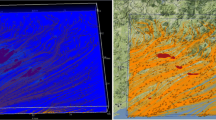Abstract
A recently developed data presentation technique, the rectangular wind frequency isopleth diagram, has been applied to examine the effect of wind speed and direction, acting simultaneously, on ambient air negative ion densities. The large negative ion concentration decreases in the majority of directions and wind speed intervals, while that of the small ions increases, as the wind speed increases. The local maxima and minima, occurring in some sectors, are properly discussed.
Similar content being viewed by others
References
Bower, J. S., andSullivan, E. J. (1981),Polar Isopleth Diagrams: A New Way of Presenting Air-Pollution Data. Atmos. Environ.15, 537–540.
Cobb, W. E. (1968),The Atmospheric Electric Climate at Mauna Loa Observatory, Hawaii, J. Atmos. Sci.25, 470–480.
Kamst, F. H., Lyons, T. J., andCarras, J. N. (1980),Windfield Analysis of the Kwinana Industrial Region. Arch. Met. Geoph. Biokl. Ser. B28, 15–30.
Landsberg, H. E. (Editor in Chief),World Survey of Climatology inClimates of Central and Southern Europe, vol. 6 (ed. C. C. Wallen) (Elsevier Scientific Publishing Company, Amsterdam-Oxford-New York, 1977), pp. 191, 217–218.
Lyons, T. J. (1977),Mesoscale Flow Analysis, Arch. Met. Geoph. Biokl., Ser. B.25, 233–249.
Meteorological Institute, Nat. Obs. of Athens (Minoa, 1969),Climatological Bulletin, May–August 1969.
Meteorological Institute, Nat. Obs. of Athens (Minoa, 1971),Bulletin of Atmospheric Electricity 5.
Retalis, D. A. (1977),On the Relationship Between Small Atmospheric Ions Concentration and (1) Smoke, (2) Sulphur Dioxide and (3) Wind Speed, Pure Appl. Geophys.115, 575–581.
Retalis, D. A., andZambakas, J. D. (1975),The Influence of Temperature and Relative Humidity of the Air on Atmospheric Small Ion Concentrations over Athens, Proceedings of the Academy of Athens50, 96–106.
Saxer, L., andSigrist, W. (1966), Die Luftelektrische Station in Aarau, Schweiz.
Seppälä, M. (1977),Frequency Isopleth Diagram to Illustrate Wind Observations, Weather32, 171–175.
Turner, D. B.,Workbook of Atmospheric Dispersion Estimates (Department of Health Education and Welfare, Cincinnati, Ohio, 1969), 5 pp.
Wright, H. L. (1934),The Association Between Relative Humidity and the Ratio of the Number of Large Ions to the Total Number of Nuclei. Terr. Magn. Atmos. Elect.39, 277–280.
Zambakas, J. D. (1982),Frequency Isopleth Diagram: A New Way of Presenting Wind Observations. Weather37, 80–82.
Zambakas, J. D., Angouridakis, VI. E., andKotinis, S. R. (1982)Simultaneous Interpretation of Wind Speed and Direction to Study Air-Pollution from Smoke, at the National Observatory of Athens, Greece, Zeitschrift für Meteorologie32/6, 369–371.
Author information
Authors and Affiliations
Rights and permissions
About this article
Cite this article
Zambakas, J.D. A simultaneous interpretation, by wind speed and direction, of ambient air negative ion density in Athens, Greece. PAGEOPH 120, 691–697 (1982). https://doi.org/10.1007/BF00876654
Received:
Issue Date:
DOI: https://doi.org/10.1007/BF00876654




